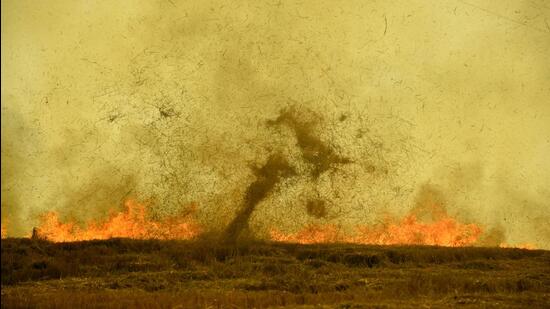Ecostani: Link between rise in wildfires and atmospheric convection
In the long term, wildfires interrupt terrestrial carbon uptake, potentially accelerating anthropogenic global warming.
With rising temperatures globally, the incidence of wildfires has increased across the world including India, disturbing the natural system in several ways.

A new global study based on satellite imagery has added a new dimension to what is already well-documented about wildfires. That is, atmospheric convention also plays a significant role in triggering forest fires, especially in low human- impact regions of the world including in South Asia.
The study can provide some insight into rising forest fires in India, whose period is mainly from March to May. As per the Forest Survey of India data, the number of forest fires has fluctuated from 8,430 fires in 2005 to 1,04,500 recorded in 2021. The data clearly shows that there is an increase in forest fires since 2010, especially in Himalayan and Deccan regions, which has witnessed deforestation of quality forests.
The study titled, ‘Convective potential and fuel availability complement near-surface weather in regulating global wildfire activity’ said that enhanced atmospheric convection is identified for over 40% of the fires in low-human-impact regions and 61% in other places, where local ignition is also available.
“Our results highlight the role of (atmospheric) convection and fuel in wildfire forecast, prompting a revisit of wildfire prediction under intertwined atmospheric and terrestrial changes,” the study conducted by Beijing’s Peking University researchers said.
The study also said that wildfires rely on the availability of ignition and fuel, which are underrepresented in fire forecast and prediction practices, a reason for setback to preventive steps. It also said that most prediction indices are based only on meteorological inputs like in India and indicate fire potential in the presence of ignition sources but fails to predict on past occurrence and intensity of wildfires.
“By analysing satellite measurements and atmospheric reanalysis, here we show that near-surface weather only partially captures wildfire occurrence and intensity across the daily to seasonal timescales. Beyond near-surface weather, convection and fuel abundance play a complementary role in regulating burning processes,” the study based on analysis of satellite measurements of fire activity across the globe during 2012 to 2023 said.
The study also found that mid-to-high latitudes of both hemispheres see most frequent and intensive burning in local summer and autumn, whereas the subtropics show high wildfire activity in local winter and spring. However, the wildfire peak time exhibits more complicated patterns in low latitudes. For instance, the wildfire activity reaches its peak from July to September across the tropical rainforests in Amazon, Congo, and Maritime Continents. North of these regions, such as in the sub-Saharan North Africa, fire events are most active from December to February.
The study said that the wildfires present an essential component in the earth system, shaping the evolution of plants, animals, and biogeochemical processes and also exert a series of disturbances to the Earth and human systems.
In the short term, wildfires cause substantial losses of infrastructure and life; at the land surface, large wildfires reduce vegetation cover and soil adhesivity, turning vegetated landscapes into inhabitable ecosystems and even temporary dust sources; and in the atmosphere, smoke aerosols released deteriorate regional air quality, interfere in global radiation budget, and even disturb stratospheric ozone recovery. In the long term, wildfires interrupt terrestrial carbon uptake, potentially accelerating anthropogenic global warming.
“Given these natural and socioeconomic disturbances imposed by wildfires, the recent spike of megafires has raised an unprecedented need to understand how they occurred and intensified,” the study emphasised.
It added that the atmospheric instability associated with lightning has been proved to be important in fire growth in local scale and gave example of North American boreal forests, where record-breaking amounts of lightning ignitions associated with strong atmospheric convection has contributed to the recent extreme fire years with large burned area.
The connection between wildfires and atmospheric convection is further demonstrated through analyses facilitated by the recently developed global maps of wildfire ignition sources and the North American fire inventories that distinguish between lightning-ignited and human-caused wildfires.
“The availability of fuel and anthropogenic ignition apparently promotes the coherence between fire weather and actual wildfire activity. Lands with abundant vegetation, namely, forests and savannas, show wider significance of wild fires as compared with the relatively sparsely vegetated grasslands and shrublands,” the study said.
Likewise, regions with abundant anthropogenic ignitions, e.g., tropical Africa, South East Asia, and South Eastern Australia, witness a closer linkage between fire weather and wildfires. Yet, there exists regions, e.g., south eastern United States, where human ignition is abundant but the coherence between Fire Weather Index (FWI) and actual fire activity is limited, the study said.
All Access.
One Subscription.
Get 360° coverage—from daily headlines
to 100 year archives.



HT App & Website







